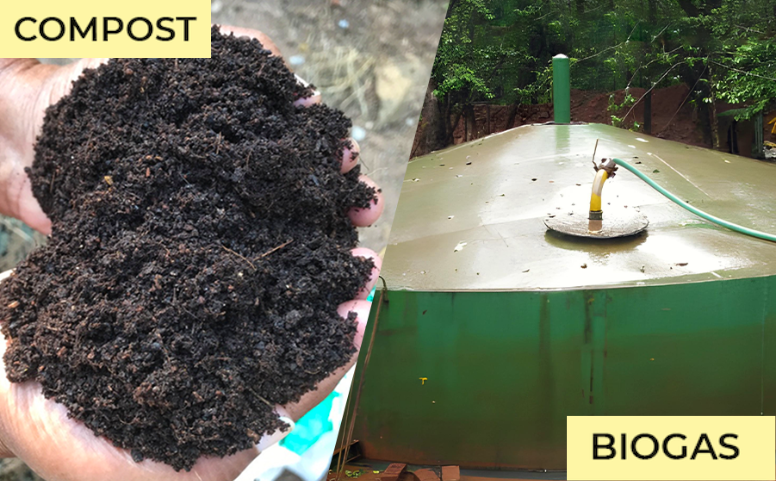Indian villages typically have considerable amount of biomass in the form of Cow dung, Sheep/Goat dung, Crop Residues, Leaves & Twigs of trees, Dry grass etc.
Current practice of putting all the animal dung and residues to a pit and let it decompose to Farm Yard Manure (FYM) is time-consuming and labor intensive
Farm Yard Manure (FYM) most often does not provide all required nutrients for the plants to grow
For heterogenous waste like canteen waste, bio-gas generation is not the optimal solution. Lets understand the reasons,
- This is because bio-gas works best when the waste is calorie rich and is of one type Ex. Potato peels, Starch from rice, Baking waste involving flour, fat & sugar.
- Since canteen waste has fruit & vegetable peels, egg shells, bones etc. the waste in general is not calorie rich.
- Such kind of waste when treated in bio-gas plant builds up scales in the bio-gas chamber and has to be frequently cleaned. The cost of maintenance is extremely high.
- Scale of treatment should be more than 20 tons per day using sophisticated bio-gas setup which requires constant monitoring of various bio-chemical parameters and corrections to input materials based upon the reactions in the digester.
- For every 1 ton of food waste, over 3 tons of nitrogen rich sludge is formed. There should be a process to treat this sludge and convert into non-toxic soil friendly format (i.e. composting of the sludge needs to be done)
- For 1 ton of food waste treated through anaerobic digestion, approx. 200 cubic feet of biogas is produced. Out of this, 50% is methane and rest is CO2. However the utilisation of methane has to happen at source itself.
- Botting of bio-gas under high pressure into cylinders consumes almost 70% of the energy equivalent that is put into a cylinder. So transporting bio-gas is not a sustainable option.
- Since 3 tons of semi-liquid sludge is formed for every 1 ton of food waste, the cost of composting is 3 times higher as the absorbent (carbon rich material) required will be more to absorb the moisture.
Composting on the other hand deals with all kinds of organic waste and there is only one resultant output – compost. This can be used for agricultural purposes and there is always demand for it. The benefits of the composting project can be summarized as “tangible” and “in-tangible”
TANGIBLE BENEFITS:
- Considering 1 tons of canteen waste treatment per day and using 0.5 tons of landscape waste to treat the same, we can expect an output of 0.5 tons of compost per day after 30 days. This translates into 15 tons of compost per month or 180 tons per annum
- 180 tons of compost can approximately be used to grow crops in 90-100 acres of land. Typically the basal application of compost is 2 tons per acre of farm land.
- Alternatively, the compost can be used to green the road side plants & trees and create an urban forest of over 18000 trees per annum (Dosage 10kg / plant).
- Currently there is costs associated to dispose off the landscape waste and canteen waste. This will be saved as the waste is treated within the premises.
INTANGIBLE BENEFITS:
- Savings in Green House Gases (GHG) due to daily transportation of waste outside the campus
- Over 180 metric tons of carbon per annum will be given back to the soil which helps in further carbon sequestration by the soil.
- As per scientific data available, every hectare of land treated with compost sequesters 2.5 metric tons of carbon-di-oxide from the atmosphere per annum. As and when farmers use the compost in their lands to grow food crops, the CO2 absorption by the soil is enabled
- Goodwill generated by providing compost to farmers / local communities will be significant.


